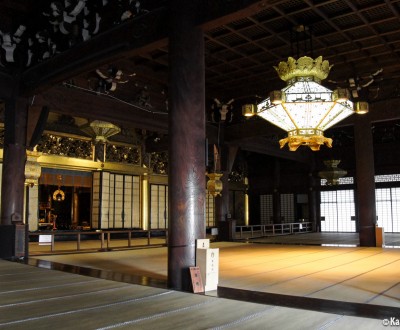Nishi Hongan-ji
Jodo-shinshu’s Head Temple
Nishi Hongan-ji is a temple belonging to the great Jodo-shinshu Buddhist sect (The True Pure land School), located on the large Horikawa avenue, next to Kyoto main station in Japan. Dating back to the 16th century, it forms a pair with the other head temple, Higashi Hongan-ji, a hundred meters away to the east. Of the two, Nishi Hongan-ji is the only one registered on the UNESCO World Heritage Site List.
As its name suggests, Nishi Hongan-ji is the western Hongan-ji. It is the smallest of the two temples, and the one offering more intimacy, despite a relatively wide outdoor space, and furthermore, not favored by tourists.
Nishi was actually the first Hongan-ji in Kyoto, after its transfer from Osaka in 1591. In 1602, famous shogun Tokugawa Ieyasu had Jodo-Shinshu sect's head temple split in two, and Higashi Hongan-ji was founded a couple of hundred of meters away. Both underwent a fire 🔥 in 1617, but Nishi Hongan-ji was spared from most of the damages. Therefore, most of the current constructions are still those built in the 17th century, allowing them to be listed as National Treasures of Japan.

Several pavilions stand in the temple’s grounds:
- Goei-do (dedicated to Shinran Shonin, its founder), or Founder’s Hall, achieved in 1636 and with impressive dimensions: 62 meters long, 48 meters wide and 29 meters height;
- Amida-do (dedicated to Bouddha Amida), almost as large (45 x 42 x 25 meters) rebuilt in 1760 after a fire;
- Daisho-in, a reception hall for the monks, with tatami floored rooms,
- Shoro, the small tower in the north-east, that shelters the temple’s bell (1620) ;
- and Kara-mon, a great gate with magnificent 16th century architecture, that remains closed.
Most of the rooms are decorated with beautiful lanterns 🏮, sliding doors, old wooden floorings, and several other ornaments wonderfully preserved (some are said to be parts retrieved from Fushimi Castle 🏯), that give the place a really inspiring atmosphere. A splendid gingko tree revealing marvelous golden colors in autumn 🍁 is said to have been growing in the temple’s grounds for four centuries.
If one must choose between the two Hongan-ji, we recommend visiting Nishi Hongan-ji, combined with Shosei-en garden.

